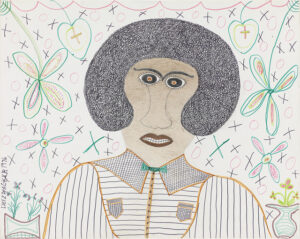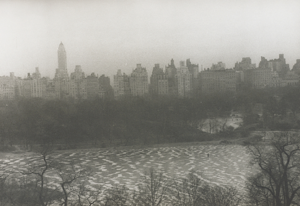
Untitled, c. 1975
Oil and collage on cardboard with plywood support. Gift of Mr. and Mrs. Lawrence B. Karter and Martin Sanders. 1979.2
Today’s post comes from Gianna Samms, class of 2019 and Art Center Student Docent.
Looking at Al Loving’s art in the Frances Lehman Loeb Art Center is an active and intense experience. Strips of painted cardboard overlay each other, forming a brilliant collage of vibrant color and form. The work is not encased in a distracting frame or distorted by a sheet of glass. Instead, his work confronts the viewer with its vivid colors and interesting form, dynamically standing out from the wall. In fact, when speaking about a Loving exhibition in 1974, art critic Peter Schjeldahl described the works as “[…] energiz[ing] the space around them, seemingly almost to be caught in the act of moving across the wall.”[1]
An African-American Abstract Expressionist artist, Al Loving (1935-2005) is best known for his exploration of color through various means including collage and painting. His early works depict coloristic geometric cubes, while later he moved towards another kind of abstraction through the use of different materials such as fabric and cardboard. His later works, like the 1975 Untitled at the Loeb, are more fluid in form, often featuring strips of overlapping material. Curator Mary-Kay Lombino describes the trajectory of his work, saying, “Loving was one of the first African-American artists to join the Abstract Expressionist painters creating geometric hard-edge compositions. However, he was not afraid to experiment and go against the trends. Loving returned to a more gestural abstract style in the 1970s decades after Pollock’s first splatter paintings, and created a new signature style.”
In Untitled, the strips of cardboard are painted in broad, bold strokes, forming a shiny enamel-like surface. Loving primarily uses warm colors like red, pink, yellow, and orange, offset with cooler shades of blues and white. Some parts of the work are further spattered with drops of paint, creating a speckled, spattered appearance. One can almost visualize Loving’s process of creation through his work’s layered pieces of cardboard covered in bright oil paint and collage. Because of this, the work is located in the twentieth-century galleries alongside works by mid-century action painters like Jackson Pollock.
To me, Loving’s piece at the Loeb is a conundrum, defying definition. The work is not quite painterly or sculptural by traditional definition but instead falls somewhere between the two. It gives me the distinct impression of conflicting fragility and durability. The materials of cardboard and plywood have connotations of hardiness. These mediums are not conventionally associated with art but instead are commonplace and industrial, frequently used in commercial construction. And yet the way Loving tears the cardboard into strips to create papery thin edges results in a sense of delicateness and uniqueness that is far from commonplace or industrial. In this manner, Loving’s unconventional use of material and method gives his work a sense of artistic individuality and self-expression.
[1] Margalit Fox, “Al Loving Dies at 69; Abstract Artist Created Vibrant Work,” The New York Times, June 30, 2005.





What a cogent and sensitive response to this collage painting artwork of Al Loving!! Al really wanted his art to attract and surprise and inspire, and Gianna Samms captures this. And yes there is a real connection to Abstract Expression in this work, and directly to Pollack.
Art = Energy
Thank you,
Mara Kearney Loving (Al’s wife)